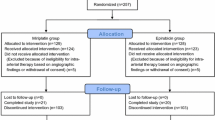Abstract
We conducted a prospective randomized trial to evaluate the efficacy of Lipiodol in intrahepatic arterial infusion chemotherapy for patients with hepatocellular carcinoma (HCC). A total of 38 patients with unresectable HCCs and underlying cirrhosis were entered in this trial, and 36 of them were evaluable. Every 4 weeks, 17 patients received 70 mg of 4′-epidoxorubicin (epirubicin) alone (group A), whereas 19 patients received a Lipiodol emulsion containing the same dose of epirubicin (group B) through the hepatic artery. A tumor response (CR+PR) was observed in 12% of group A patients and in 42% of group B patients. The group B patients showed a significantly higher response rate than the group A patients. There was a tendency for an increased duration of survival (P=0.09) in the group B patients. These results suggested that the infusion of the Lipiodol emulsion with epirubicin was more effective than epirubicin alone for the treatment of these patients with HCC.
Similar content being viewed by others
References
Chen HSG, Gross JF (1980) Intra-arterial infusion of anticancer drugs: theoretic aspects of drug delivery and review of responses. Cancer Treat Rep 64: 31
Cho KJ, Andrews JC, Williams DM, Doenz F, Guy GE (1989) Hepatic arterial chemotherapy: role of angiography. Radiology 173: 783
Konno T (1992) Targeting chemotherapy for hepatoma: arterial administration of anticancer drugs dissolved in Lipiodol. Eur J Cancer 28: 403
Leung WT, Shiu WCT, Leung N, Chan M, Tao M, Li AKC, Metreweli C (1992) Treatment of inoperable hepatocellular carcinoma by intra-arterial Lipiodol and 4′-epidoxorubicin. Cancer Chemother Pharmacol 29: 401
Takayasu K, Shima Y, Muramatsu Y, Moriyama N, Yamada T, Makuuchi M, Hasegawa H, Hirohashi S (1987) Hepatocellular carcinoma: treatment with intraarterial iodized oil with and without chemotherapeutic agents. Radiology 162: 345
Tamamoto M, Sugahara K (1992) Primary liver cancer in Japan. In: Overview of the general rules for the clinical and pathological study of primary liver cancer in Japan. Springer, Berlin Heidelberg New York Tokyo, p 385
Yoshikawa M, Ebara M, Nakano T, Minoyama A, Sugiura N, Ohto M (1992) Percutaneous transaxillary catheter insertion for hepatic artery infusion chemotherapy. AJR 158: 885
Yumoto Y, Jinno K, Tokuyama K, Araki Y, Ishimitsu T, Maeda H, Konno T, Iwamoto S, Ohnishi K, Okuda K (1985) Hepatocellular carcinoma detected by iodized oil. Radiology 154: 19
Author information
Authors and Affiliations
Rights and permissions
About this article
Cite this article
Yoshikawa, M., Saisho, H., Ebara, M. et al. A randomized trial of intrahepatic arterial infusion of 4′-epidoxorubicin with Lipiodol versus 4′-epidoxorubicin alone in the treatment of hepatocellular carcinoma. Cancer Chemother. Pharmacol. 33 (Suppl 1), S149–S152 (1994). https://doi.org/10.1007/BF00686689
Issue Date:
DOI: https://doi.org/10.1007/BF00686689




